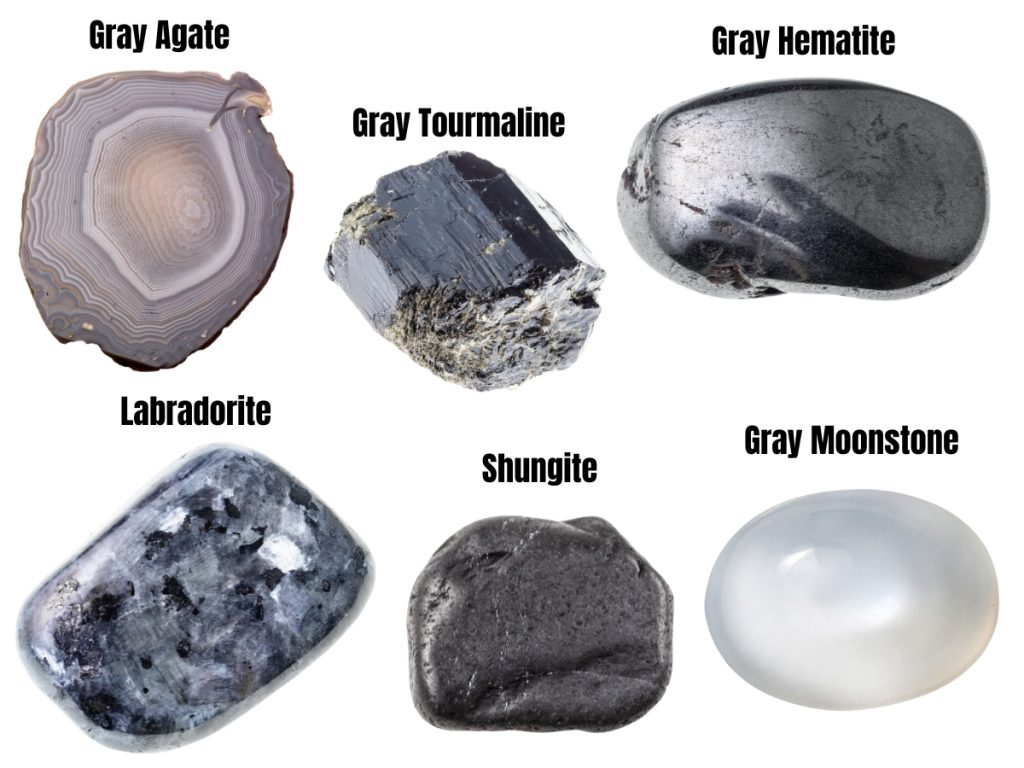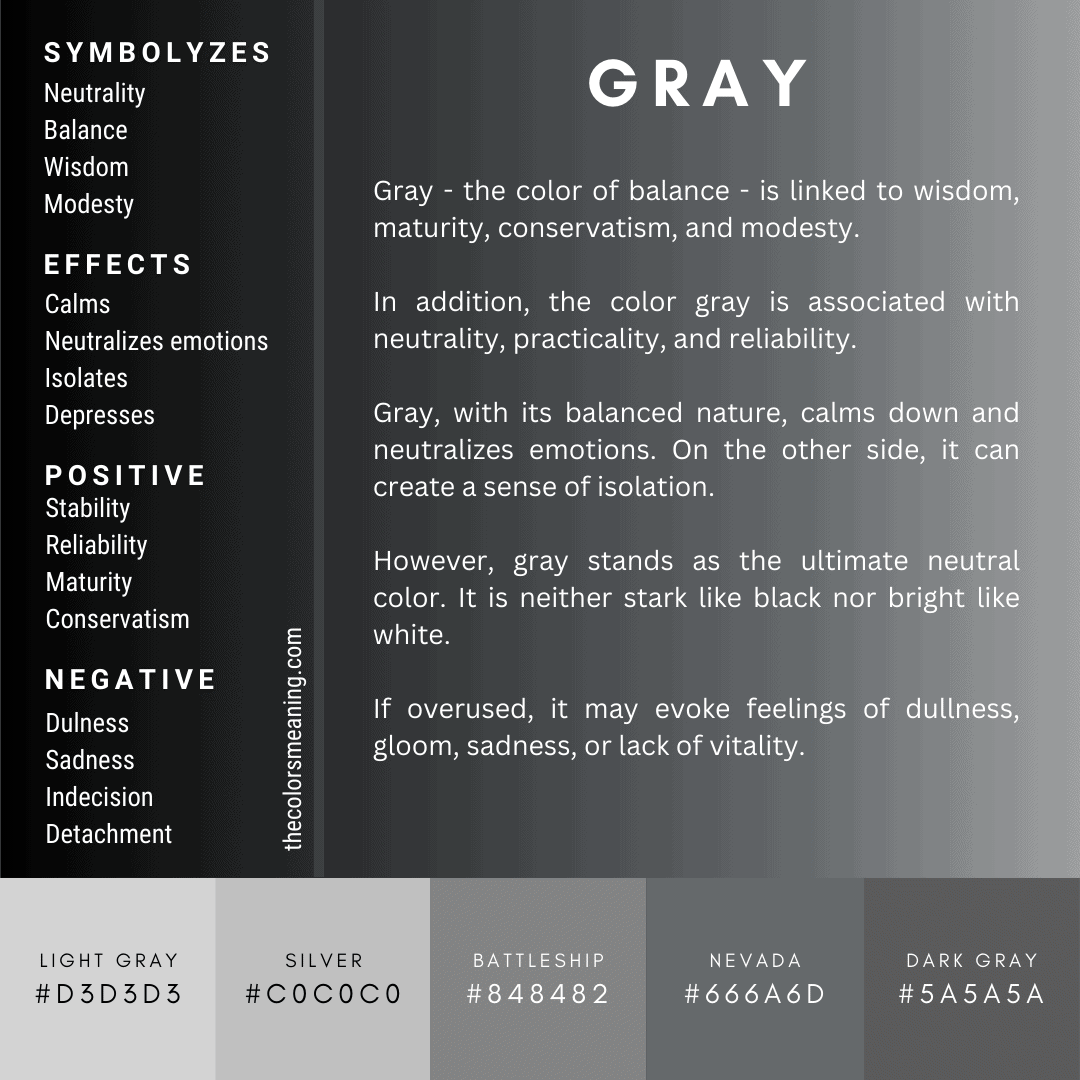Are you curious about the meaning of the color gray? Gray is the color of wisdom and intellect. It symbolizes neutrality and balance.
But gray also represents intellect and compromise. It is regarded as elegant and conservative. As a result, the meaning of gray lies between the extremes, acting as a bridge between them.
In today’s article, we will discuss the meaning of the color gray, its symbolism, and what it means spiritually.
Gray Color Symbolism in Different Cultures
In Western culture, gray symbolizes modesty, dignity, practicality, maturity, reliability, neutrality, and indecision. It is also associated with gloominess, depression, and boredom due to its subdued nature.
Additionally, gray is frequently tied to wisdom and knowledge, likely because of its association with old age (gray hair).
In Europe, gray is one of the least favorite colors associated with the period of war and industrialization in the 1930s. Thus, it can be associated with sadness.
For the Celts, gray was linked to the Fairy realm, the otherworldly, and the liminal space between life and death. It was a color of mystery and magic.
In Africa, gray is the color of peace and joy because it is associated with the moon.
Among Native American cultures, gray symbolizes friendship and honor.
In ancient Egypt, gray is connected to the Egyptian gods because it is the color of the stark plumage. This bird was seen as a guide and was associated with creation and rebirth.
Bennu, the Egyptian deity representing creation, was often depicted as a heron in Egyptian art. Bennu was also closely related to the sun god Ra and the god of the underworld, Osiris.
In China, gray is associated with humility and modesty. Similarly, Japan sees it as modest, refined, and sometimes related to something older or traditional. In the Hindu religion, the deities often depicted in gray are typically associated with destruction or transformation.
What Does the Color Gray Mean Spiritually?
Spiritually, the color gray symbolize neutrality and balance. It represents the middle ground between black and white, embodying life’s darkness and light.
Moreover, gray signifies transition, as it is an in-between color, potentially symbolizing a spiritual journey or transformation.
Furthermore, gray might be associated with maturity, wisdom, and responsibility, as these traits are often linked to aging, symbolized by gray hair.
But what does the color gray mean in the Bible? Let’s discover.
What Does the Color Gray Mean in the Bible?
In the Bible, the color gray is associated with aging and wisdom gained with age.
For example, in Genesis 18:11, Abraham and Sarah were described as “old” or “well advanced in years.” Thus, gray can be linked to wisdom and experience gained throughout life.
In the Old Testament, the color gray is associated with gray hair and is mentioned 19 times.
A famous proverb says that gray hair is a “crown of glory if found in the path of righteousness.” (Proverbs 16:31)
Thus, gray is associated with gray hair, and hence the multitude of years has been associated with wisdom.
If you want to learn more, check out the meaning of colors in the bible.
Psychological Meaning of Gray
In color psychology, gray symbolizes wisdom, neutrality, and wisdom. It is the color of balance because it is a combination of black and white – darkness and light.
It combines the stimulating effect of brightness and the relaxing effect of darkness. So it can be considered a passive color.
Gray Color Meaning
Gray is perceived as a conservative, quiet, and calm color. So, what does the color gray symbolize? Here are all the meanings of gray.
Wisdom

The gray color is associated with gray hair and aging, symbolizing experience and wisdom. In fact, wisdom comes with age, right?
So, the older you are, the more likely you are to become wiser so that you can see more perspectives (both the “black and white” and the “good and bad” sides of a situation).
But hair greying is caused by a decrease in melanin – a pigment present in hair follicles that gives hair color. [1]
Conservatism
Gray is a color that falls somewhere between black and white. This neutrality is comparable to the conservative approach, which frequently seeks to balance preserving traditional values and adapting to unavoidable change.
Moreover, gray is a stable and reliable color, not subject to the whims of trends or fashion. This reflects the conservative perspective, which underlines the importance of steadfast principles.
Modesty
Gray is not a bright or flashy color. It tends not to draw attention to itself, which resonates with ideals of modesty and discretion.
But gray is also associated with humility. This quality comes from the Tironesian Order – a medieval monastic order founded in 1109.
The monks from the Tironensian Order, also known as the “Gray Monks” due to their gray robes, adopted this color likely as a symbol of their vows of poverty, humility, and asceticism.
This symbolism is also related to other spiritual traditions in which this color is associated with simplicity and humility.
Seriousness
The color gray is neutral and balanced, neither stark like black nor attention-grabbing like brighter colors. This neutrality is linked to a serious, calm, or subdued mood.
In many professional and formal settings, gray is a preferred color for attire. Consider the classic gray business suit: it’s formal, professional, and suitable for various serious occasions.
Passivity and Lack of Emotion
Gray is associated with passivity and lack of emotion due to its neutral position.
While warm colors are associated with strong emotions, having a stimulating effect, cool colors symbolize calm and relaxation. But gray is impartial and passive.
Its subdued nature can symbolize a lack of emotional intensity.
Mystery and Ambiguity

Because gray can be anywhere between black and white, it can be associated with ambiguity, uncertainty, and mystery.
That’s because it reminds us of foggy mornings, cloudy skies, or that dim light at dusk. These moments have a bit of a hush, a hint of the unknown.
Physical Effects of Gray
The color gray has a calming effect on our moods. That’s because bright colors stimulate our senses and evoke strong emotional responses. In contrast, less intense gray doesn’t tend to trigger these same reactions.
Gray can also evoke a sense of isolation and alienation due to its associations with gloom, monotony, and detachment. These qualities can contribute to a feeling of loneliness or melancholy.
For this reason, gray is used in prisons or any other environment where deprivation of sensory stimulation is needed.
Meanings of Gray Shades
Light Gray symbolizes tranquility and softness, reflecting a calm and peaceful mood.
Medium Gray represents neutrality and balance, suggesting a harmonious blend of black and white.
Dark Gray is associated with seriousness, maturity, formality, and conservatism.
More Shades of Gray
When it comes to light, there are 256 achromatic shades of gray. That’s because a pixel is stored with 8 bits, meaning 256 different intensities of gray. But the human eye can perceive about 500 shades of grey.
In addition to achromatic grays, there are also grays containing blue, green, or brown in their composition.
The most popular shades of gray include charcoal, onyx, seal, smoke, iron, fossil, goose, and slate.
Common Uses of the Color Gray
Gray is a versatile color used in various contexts for its neutral, balanced, and sophisticated look. Here are some common uses of this color:
Interior Design: Gray is often used in interior design for its neutral and sophisticated appeal. It works well with a wide variety of other colors and can create a calm, soothing environment.
Fashion: Gray is a popular color for business and formal wear in fashion due to its professional and elegant appearance. It’s also widely used in casual attire for its versatility.
Branding: In branding, gray is often used to convey reliability, professionalism, and balance.
Automobiles: Gray is a common color for vehicles, reflecting a sense of elegance, sophistication, and practicality.
Art: In art, gray can be used to create depth, shadows or to mute more vibrant colors. It can also be used to create a particular mood.
Companies That Use Gray in Their Logo

Grey has many uses because it is neutral and has a luxurious look when used properly. Furthermore, it is associated with wisdom, neutrality, and balance.
Thus many big companies use it in their branding campaigns.
Companies that use gray in their logos include the BBC, Apple, WordPress, and Wikipedia, as well as several automotive manufacturers such as Toyota, Audi, Mercedes, and Nissan.
Gray Gemstones

There are plenty of things that are gray in nature, and many of these are rocks or gemstones.
Gray moonstone, gray chalcedony, gray agate, gray chalcedony, and gray diamond are among the gray gems.
Gray moonstone is one of the most beautiful gray gemstones. It is believed that this stone harvests the energy of the moon. It is also associated with friendship and love and is also called the “love stone.”
Gray chalcedony is a rock with a microcrystalline structure, which makes it rank close to 7 on the Mohs scale.
Gray agate is a rock formed predominantly of cryptocrystalline silica, distinguished by its fineness and variety of colored bands. This is a symbol of courage and strength.
Grey hematite is an iron-rich gem, which gives it a metallic luster. It is said to be a stone that offers protection and protection, absorbing negative energies.
Facts About the Gray Color
- According to color psychology, people who favor gray are often practical, calm, composed, and reliable and may prefer a compromise rather than confrontation.
- According to a study published by researchers at the University of Freiburg (Germany), depressed people have difficulty detecting differences in contrast between black and white. So they tend to see the world more in grey. [2]
- The earliest gray pigments used in art were made from ground slate or lead.
- Gray is one of the most uncommon eye colors in humans. Only 3% of people have gray eyes. [3]
- The grey color of the eyes is caused by a reduced amount of melanin pigment in the front layer of the iris compared to the back layer. This does not mean a pure gray but a bluish or greenish gray. [4]
- The moon, which appears gray from Earth, is very similar in color to asphalt.
- Grey is an achromatic color, along with black and white. That means it has lightness but lacks hue and saturation.
- Gray vs. Grey: In American English, “gray” is the preferred spelling, while “grey” is the favored spelling in British English. Both spellings mean the same color and can be used interchangeably.
- In neuroscience, “gray matter” refers to brain areas involved in muscle control, sensory perception, memory, emotions, and speech. It’s called “gray” because it has a pinkish-gray color.
Idioms Related to Gray
- Gray area: It refers to a situation that is unclear or undefined, neither black nor white.
- Gray matter: This phrase is often used to refer to the brain or intelligence
- Get gray hair from: It means to become very stressed or worried due to someone or something.
- Growing gray: This refers to aging, as gray hair is a common sign of aging.
- All cats are gray in the dark: This proverb means that differences become indistinguishable in certain situations.
Summary Color Gray Meaning
Gray means: neutrality, balance, wisdom, modesty
Effects of gray: calms, isolates, neutralizes, depresses
Positive traits: stability, reliability, maturity, professionalism
Negative traits: dullness, sadness, indecision, detachment

